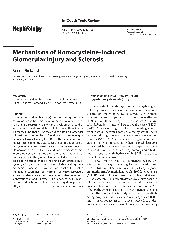摘要
Hyperhomocysteinemia (hHcys) has been recognized as a critical risk or pathogenic factor in the progression of end-stage renal disease (ESRD) and in the development of cardiovascular complications related to ESRD. Recently, evidence is accumulating that hHcys may directly act on glomerular cells to induce glomerular dysfunction and consequent glomerular sclerosis, leading to ESRD. In this review, we summarize recent findings that reveal the contribution of homocysteine as a pathogenic factor to the development of glomerular sclerosis or ESRD. In addition, we discuss several important mechanisms mediating the pathogenic action of homocysteine in the glomeruli or in the kidney, such as local oxidative stress, endoplasmic reticulum stress, homocysteinylation, and hypomethylation. Understanding these mechanisms may help design new approaches to develop therapeutic strategies for treatment of hHcys-associated end-organ damage and for prevention of deterioration of kidney function and ultimate ESRD in patients with hypertension and diabetes mellitus or even in aged people with hHcys.
- 出版日期2008
